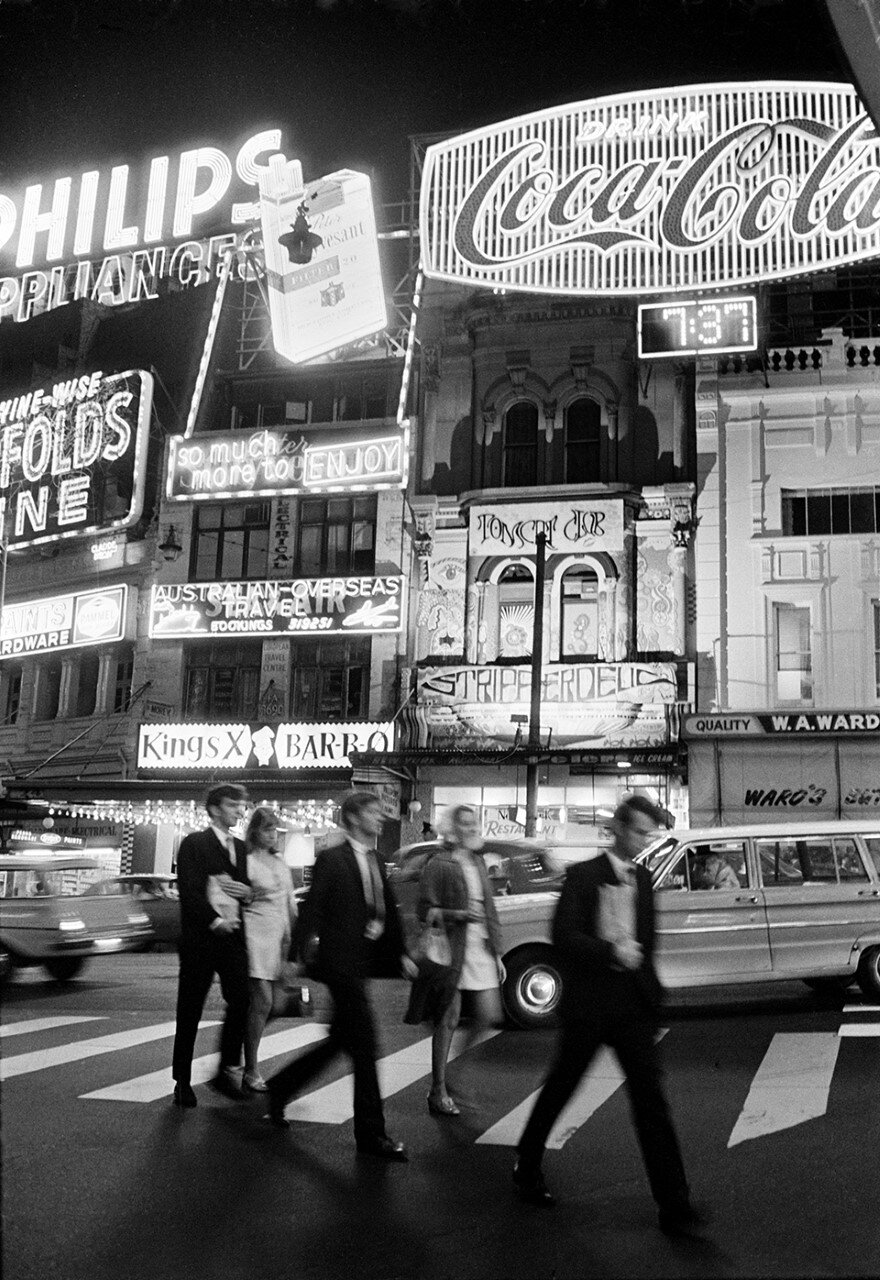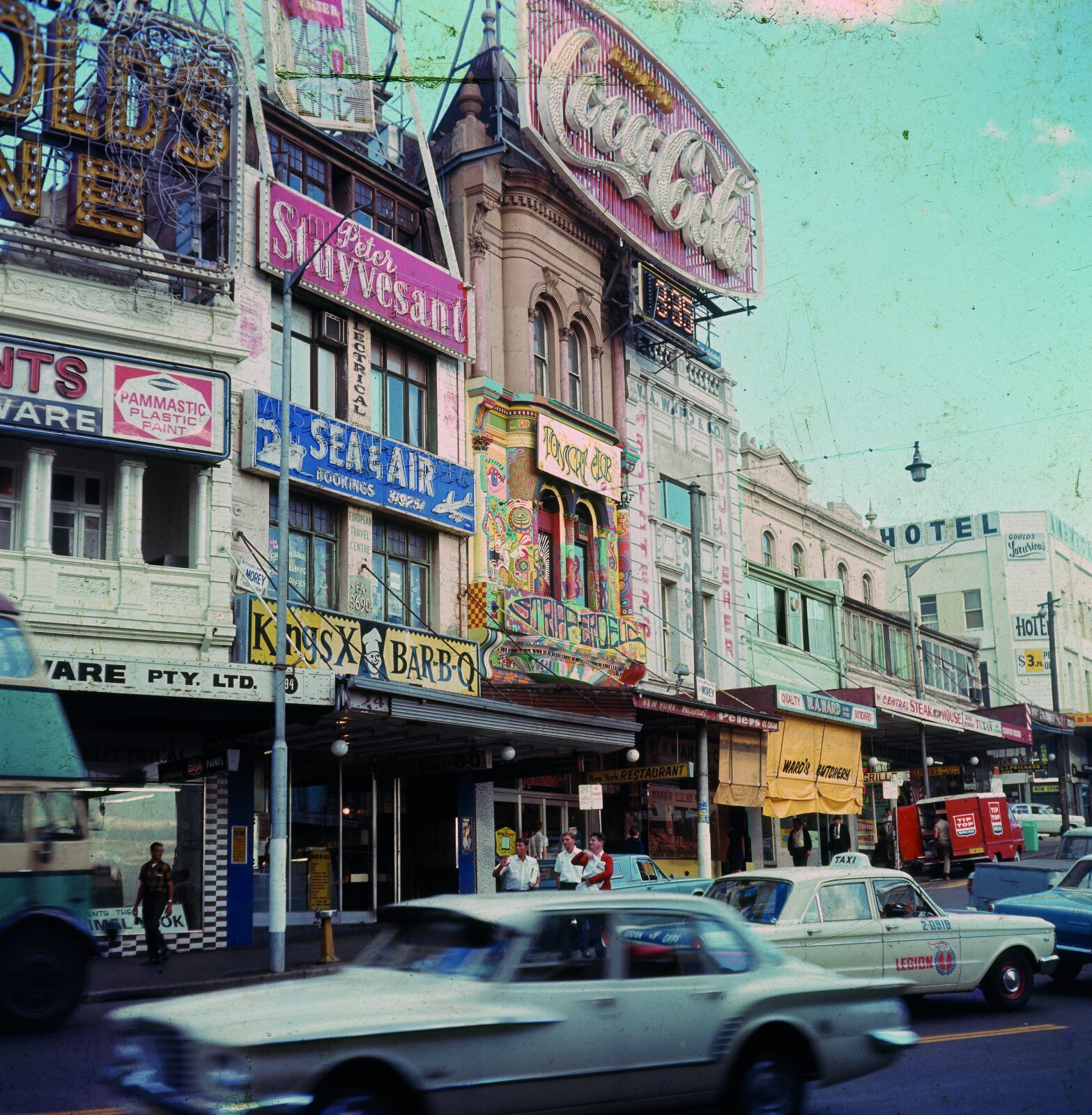Words by Alice Steele
Alice has been pole dancing for three years and studying town planning for just as long. She has developed an interest at the intersection of planning and the adult industry, and is currently undertaking her final year thesis on the impacts of planning regulations for brothels across the Sydney region.
Kings Cross is a suburb in Sydney which has long been a working class area and home to many of Sydney’s adult industry businesses throughout the previous decades. The Cross has been home to many of Sydney’s most famous entertainment venues, bohemians and Australia’s earliest strip clubs.
Photo By James Fitzpatick
The Cross is located on Gadigal Land, east of Sydney’s CBD. The first European buildings erected in the area consisted of mills and industrial buildings in the 1810s and 1820s, however a grand plan for neighbouring Darlinghurst to become a high end residential area soon emerged. Throughout the mid 1800s, the area densified with the development of townhouses and terraces. Following the economic depression of the 1890s, the area was home to many boarding houses and was established as a working class area. The suburb has always been ahead of its time, it was known for the development of apartment buildings, predominantly 6-8 storeys utilising the increasingly common invention of the lift.
During the 1910s, Kings Cross began to develop its reputation for dining and entertainment. The Kings Cross theatre opened in 1916 and soon after, cafés and restaurants appeared around it, taking advantage of the theatre’s drawing power. The Cross came into its own throughout the 20s and 30s as the café culture developed, the area became more ethnically diverse due to the influx of European migrants in the Inter-war period, and a cabaret scene emerged.
“Kings Cross was a place filled with bottle-ohs, limousines, paupers' funerals, police patrols, millionaires, American actresses, mysterious screams, and people who don't pay their taxi-fares. It is a stone chasm echoing with romance and adventure – and hidden drunks.'
With troops landing in the nearby Garden Island naval base during World War II and the Korean War, Kings Cross became a popular area for soldiers from overseas to spend their time. While many restaurants catered to the tastes of the American troops, specialised delicatessens and grocery stores catered to a range of migrants fleeing the growing threat of fascism in Europe. The first nightclub in the area providing drinks and live music was the fifty-fifty club, opening in the early 30s.
During the 1950s, topless bars and strip clubs first emerged. The Roosevelt first introduced topless showgirls in the early 50s and the Staccato Club opened in 1959 as the first strip club in Australia. Darlinghurst Road soon took on the moniker of ‘the strip’ and the area was lit up with neon signage. During the advent of the Vietnam war, thousands of US servicemen visited the cross on Rest and Recreation and were drawn to early strip clubs such as the Pink Pussycat, the Pink Panther, and the Kit Kat club among others. The long running cabaret show Les Girls was established in 1963, featuring a cast of 11 performers who would lip sync songs by artists such as Shirley Bassey and Eartha Kitt. The show featured transgender and drag performers – often at odds with wider societal views on gender and sexuality. The most famous of the performers, Carlotta, became a well known activist for transgender rights and in 2018 a bronze statue was dedicated to her in Kings Cross.
Photo by Ron & Elizabeth Morrison 1960s
During the 1950s, topless bars and strip clubs first emerged. The Roosevelt first introduced topless showgirls in the early 50s and the Staccato Club opened in 1959 as the first strip club in Australia. Darlinghurst Road soon took on the moniker of ‘the strip’ and the area was lit up with neon signage. During the advent of the Vietnam war, thousands of US servicemen visited the cross on Rest and Recreation and were drawn to early strip clubs such as the Pink Pussycat, the Pink Panther, and the Kit Kat club among others. The long running cabaret show Les Girls was established in 1963, featuring a cast of 11 performers who would lip sync songs by artists such as Shirley Bassey and Eartha Kitt. The show featured transgender and drag performers – often at odds with wider societal views on gender and sexuality. The most famous of the performers, Carlotta, became a well known activist for transgender rights and in 2018 a bronze statue was dedicated to her in Kings Cross.
However, the excitement of the Cross was not always glitz and glamour.
In October 1973, a number of strippers from the Pink Panther and the Staccato joined the Actors Equity union in order to take action and demand better working conditions. While the union was initially dismissive of the dancer’s concerns about violence and poor working conditions, they subsequently changed their view. With no progress three weeks into the strike, the unions requested that the State Labour Council cut off supplies, goods and services to the clubs. A protest march was held by workers, with support from the union and only days later the Staccato club blew up in an explosion caused by petrol spread on the club’s floor. The Builder’s Labourers Federation placed a work ban on the site, refusing to rebuild it until the strike had been settled. The strike ended in December 1973 with the Pink Panther agreeing to better pay and working conditions.
The Builder’s Labourers Federation was also involved in other areas of Kings Cross in 1973 as they instated a ban on the demolition of working class residences in Victoria Street Kings Cross. Houses in Victoria Street were bought up by developers such as Frank Theeman, whose links to organised crime were well established. The bans resulted in numerous run ins with underworld figures as the residences were vandalised and residents threatened. In one high profile case in 1975, activist Juanita Neilson disappeared after last being seen in a club in Kings Cross and her body has never been found. While the ban prevented the overdevelopment of the area, it was forced to be lifted and failed to retain a significant proportion of low income housing stock.
In 1978, a protest march calling for an end to discrimination against homosexuals in employment and housing, an end to police harassment and the repeal of all anti-homosexual law began in Oxford Street and dispersed in Kings Cross. This protest would later become Sydney’s annual Lesbian and Gay Mardi Gras. Although the organisers had obtained permission for the protest, it was revoked and 53 protesters were arrested. The following morning the Sydney Morning Herald published the names of those arrested, leading to many being outed to their friends, family and workplaces.
From the 80s onwards, the area continued to be home to many late night venues. The reputation of the Cross struggled through the 80s and 90s with a series of Royal Commissions into police corruption and links to organised crime. With the introduction of the lockout laws in 2014, many businesses throughout the Cross and other areas of the city struggled with late night patrons. The recent COVID-19 pandemic has also had a devastating impact on the night time economy. The recent lifting of the lock-out laws in Kings Cross seeks to support businesses struggling through the pandemic however the results are yet to be seen.
Kings Cross has always been an everchanging suburb, providing entertainment for the rest of the city. It has been notorious as a red-light district, a home to bohemians, crime groups and outcasts. It has often led Sydney in global trends from coffee shops to strip clubs. As Wesley Stacey and Rennie Ellis stated in 1971:



